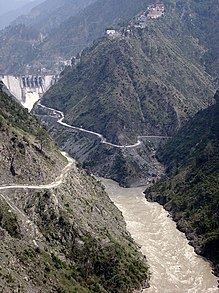Opening date 2008 Height 144 m Construction began 1999 | Location Jammu and Kashmir Type of dam Gravity Length 317 m (1,040 ft) Opened 10 October 2008 | |
 | ||
Similar Kishanganga Hydroelectric Plant, Dul Hasti Hydroelectric Plant, Ratle Hydroelectric Plant, Nimoo Bazgo Hydroele, Uri Dam | ||
Baglihar dam on j k highway
Baglihar Dam (Hindi: बगलिहार बाँध Baglihār Bāndh), also known as Baglihar Hydroelectric Power Project, is a run-of-the-river power project on the Chenab River in the southern Doda district of the Indian state of Jammu and Kashmir. This project was conceived in 1992, approved in 1996 and construction began in 1999. The project is estimated to cost USD $1 billion. The first phase of the Baglihar Dam was completed in 2004. With the completion of the second phase on 10 October 2008, Prime Minister Manmohan Singh of India dedicated the 900-MW Baglihar hydroelectric power project to the nation.
Contents
- Baglihar dam on j k highway
- Map of Baglihar Dam 182143
- Baglihar dam
- Design controversy and verdict
- References
Map of Baglihar Dam, 182143
Baglihar dam
Design controversy and verdict
After construction began in 1999, Pakistan claimed that design parameters of Baglihar project violated the Indus Water Treaty (full text) of 1960. The treaty provided India with exclusive control over three eastern rivers, Near Beacon tunnel while granting Pakistan exclusive to three western rivers, including Chenab River. However it contained provisions for India to establish run-of-the-river power projects with limited reservoir capacity and flow control needed for feasible power generation. Availing this provision India established several run-of-the-river projects, with Pakistan objecting to these. Also in the case of the Baglihar and Kishanganga Hydroelectric Plants, Pakistan claimed that some design parameters were too lax than were needed for feasible power generation and provided India with excessive ability to accelerate, decelerate or block flow of the river, thus giving India a strategic leverage in times of political tension or war.
During 1999-2004 India and Pakistan held several rounds of talks on the design of projects, but could not reach an agreement. After failure of talks on January 18, 2005, Pakistan raised six objections to the World Bank, a broker and signatory of Indus Water Treaty. In April 2005 the World Bank determined the Pakistani claim as a ‘Difference’, a classification between the less serious ‘Question’ and more serious ‘Dispute’, and in May 2005 appointed Professor Raymond Lafitte, a Swiss civil engineer, to adjudicate the difference.
Lafitte declared his final verdict on February 12, 2007, in which he upheld some minor objections of Pakistan, declaring that pondage capacity be reduced by 13.5%, height of dam structure be reduced by 1.5 meter and power intake tunnels be raised by 3 meters, thereby limiting some flow control capabilities of the earlier design. However he rejected Pakistani objections on height and gated control of spillway declaring these conformed to engineering norms of the day. India had already offered Pakistan similar minor adjustments for it to drop its objection. The Indus Waters Treaty of 1960 divided the Indus river — into which the Chenab flows — between the two countries and bars India from interfering with the flow into Pakistan while allowing it to generate electricity. However the key issue that any dam constructed by India should be strictly run of the river was rejected. Pakistan government expressed its disappointment at the final outcome. Both parties (India and Pakistan) have already agreed that they will abide by the final verdict.
The verdict acknowledged India's right to construct 'gated spillways' under Indus water treaty 1960.The report allowed pondage of 32,580,000 cubic metres as against India's demand for 37,500,000 cubic metres. The report also recommended to reduce the height of freeboard from 4.5 m to 3.0 m.
On June 1, 2010 India and Pakistan resolved the issue relating to the initial filling of Baglihar dam in Jammu and Kashmir with the neighbouring country deciding not to raise the matter further. The decision was arrived at the talks of Permanent Indus Commissioners of the two countries who are meeting. "The two sides discussed the issue at length without any prejudice to each other's stand...Indian and Pakistani teams resolved the issue relating to initial filling of Baglihar dam after discussions," sources said. Pakistan also agreed not to raise the issue further.
